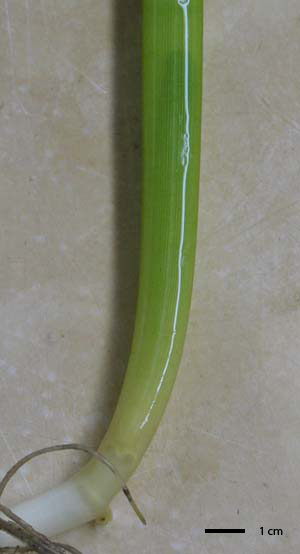
MORPHOLOGY
|
Schematic illustrating the morphological characteristics of Z. marina. Requirements
|
|
Z. marina rhizome with numerous roots
Rhizome
Seagrasses are rhizomatous plants, meaning that they have stems extending horizontally below the sediment surface. The rhizome is responsible for the extension of the plant in space, as well as for connection with neighbouring tissue, to maintain communal integration. Rhizomes are leptomorphic and contain large lacunae in the outer cortical tissue, which allow efficient accumulation and pressure-driven flow of gases (Hemminga & Duarte, 2000). The rhizome is found buried in the sediment, where it provides anchorage and mechanical support. It also functions as a structure for nutrient storage and regulation, and maintenance of vegetative growth (Kuo & Hartog, 2006)
Roots
Commonly, 2-12 unbranched, slender roots are present with numerous long hairs for anchorage in muddy to sandy substrate (Larkum et al., 2006). Seagrass roots have a system of large lacunae in the middle cortex, allowing pressure-driven flow of oxygen from photosynthetic parts to the roots (Hemminga & Duarte, 2000).
Running horizontal along the root are meristematic cells - a continuous set of dividing cells for generation. The roots are therefore protected with a 'root cap'.
Z. marina stem
Stem
Erect stems form at each rhizome node. Internodes and stems have a similar transverse section – same tissue arrangement as roots (Kuo & Hartog, 2006). Surrounding the stem is a protective basal sheath (often buried in the sediment). The basal sheath often lacks chlorophyll in the epidermis, but it encloses and protects the meristem, and newly formed leaves - which emerge enclosed within the leaf sheath of the previously formed leaf (Hemminga & Duarte, 2000).
Z. marina leaf joint
Z. marina leaf blade
Distal Blade
Located in numerous numbers and above the sediment, the distal blades produce food via photosynthesis in the epidermis, and water vapour through transpiration - leaves of seagrasses are covered by a thin, porous cuticle, across which the transfer of gases and solutes takes place (Kuo & Hartog, 2006).
Leaf blades often contain large fibre cells, near the leaf margins. These fibre cells provide longitudinal strength for the maintenance of structural integrity under wave activity, and they also determine the motion of leaves (Hemminga & Duarte, 2000).
Growth: Seagrasses only have an apical meristem; hence the full length of the leaves and sheaths is produced by the activity of the basal meristem.
Seagrass plant structures consist of 3 basic tissue layers, each with different form and function:
- Epidermis – continuous layer on the surface of the plant body, with a cuticle for mechanical protection and the restriction of transpiration and aeration.
- Vascular bundle – contains phloem for solute translocation, and xylem for water transport.
- Parenchyma tissue – responsible for photosynthesis and storage.
Difference between seagrasses and terrestrial plants :
The major differences include; the lack of stomata, the epidermis is the main photosynthetic site, and they have reduced water-conducting elements (Hemminga & Duarte, 2000).
© Jessica Smith 2008
Hemminga. M, C. Duarte. (2000). Seagrass Ecology. Cambridge. UnitedKingdom.
jKuo, J, C. Hartog (2006) In: Larkum.A, R.Orth, C.Duarte. (2006). Seagrasses: Biology, Ecology and Conservation. Springer.
Sculthorpe, C. (1967). The Biology of Aquatic Vascular Plants. London: Arnold.
Zimmerman, R (2006) In: Larkum.A, R.Orth, C.Duarte. (2006). Seagrasses: Biology, Ecology and Conservation. Springer.




